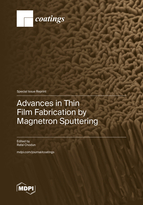Advances in Thin Film Fabrication by Magnetron Sputtering
A special issue of Coatings (ISSN 2079-6412). This special issue belongs to the section "Surface Characterization, Deposition and Modification".
Deadline for manuscript submissions: closed (20 May 2023) | Viewed by 25161
Special Issue Editor
Special Issue Information
Dear Colleagues,
You are well aware that magnetron sputtering technology is one of the most popular PVD methods used in the industry. Its importance is predicted to increase due to the current developments in research centers engaged in that particular domain. Developments are due to the modifications introduced into the sputtering technology itself (e.g., the use of innovative plasma sources, innovative technical means for influencing the state of the magnetron plasma, innovative approaches to the plasma’s state and its control) and the production of new coating materials with functional properties that enable them to meet the needs of modern industry.
This Special Issue aims to present a collection of articles describing recent advances in thin-film manufacturing technology. We are particularly interested in papers focused on the influence of the modification of magnetron sputtering on the film synthesis conditions, parameters, and properties of the produced films. Additional topics of interest include (but are not limited to):
- modification of the magnetron plasma source and/or power source;
- modification of the plasma control process;
- use of additional means to support the synthesis of layers;
- use of highly non-equilibrium plasma;
- pulsed magnetron sputtering methods, e.g., HiPIMS;
- thin, metastable films;
- thin films with special structural features (nanostructures, composite films, etc.);
- thin films with special functional properties.
Dr. Rafal Chodun
Guest Editor
Manuscript Submission Information
Manuscripts should be submitted online at www.mdpi.com by registering and logging in to this website. Once you are registered, click here to go to the submission form. Manuscripts can be submitted until the deadline. All submissions that pass pre-check are peer-reviewed. Accepted papers will be published continuously in the journal (as soon as accepted) and will be listed together on the special issue website. Research articles, review articles as well as short communications are invited. For planned papers, a title and short abstract (about 100 words) can be sent to the Editorial Office for announcement on this website.
Submitted manuscripts should not have been published previously, nor be under consideration for publication elsewhere (except conference proceedings papers). All manuscripts are thoroughly refereed through a single-blind peer-review process. A guide for authors and other relevant information for submission of manuscripts is available on the Instructions for Authors page. Coatings is an international peer-reviewed open access monthly journal published by MDPI.
Please visit the Instructions for Authors page before submitting a manuscript. The Article Processing Charge (APC) for publication in this open access journal is 2600 CHF (Swiss Francs). Submitted papers should be well formatted and use good English. Authors may use MDPI's English editing service prior to publication or during author revisions.
Keywords
- Magnetron plasma sources
- Magnetron plasma characterization
- Pulsed methods of magnetron sputtering
- Thin functional films
- Nanocrystalline films






